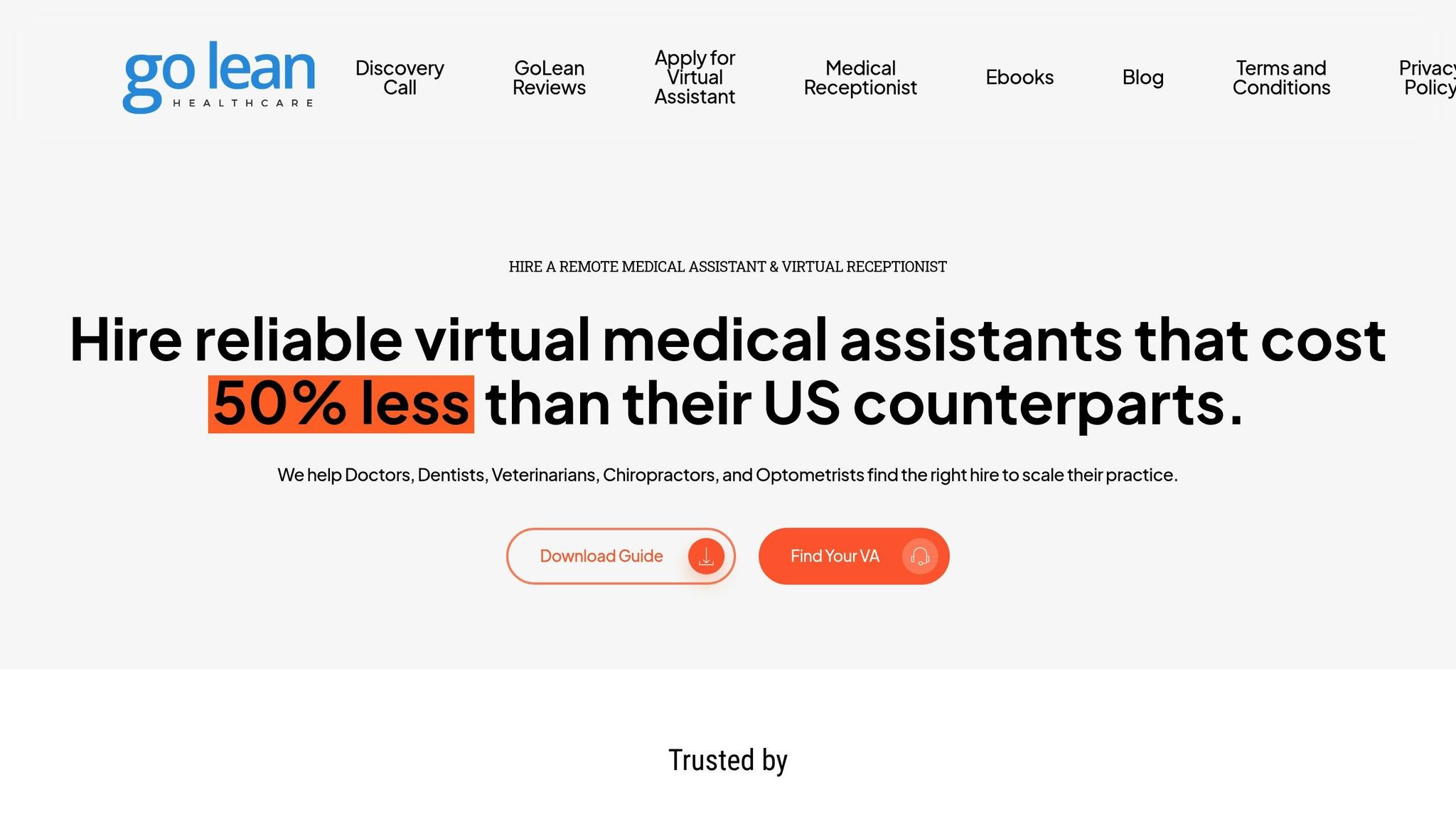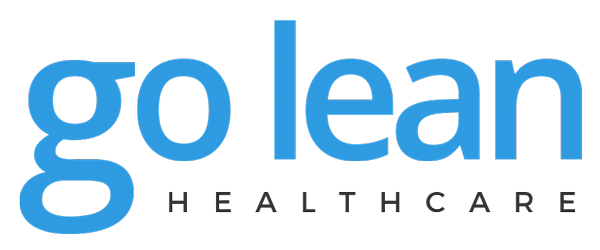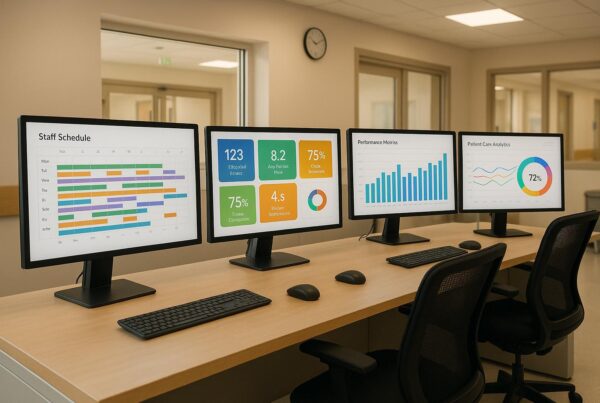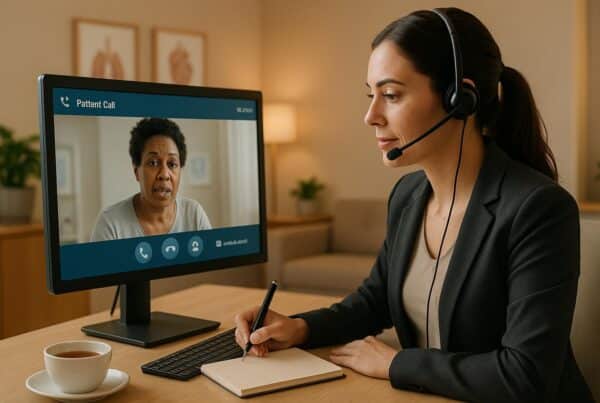Remote medical assistants (RMAs) can save your practice up to $25,000 per year per assistant. By handling tasks like scheduling, billing, and EMR management from offsite locations, RMAs reduce labor costs, eliminate overhead expenses, and improve efficiency. Here’s how they help:
- Lower Labor Costs: RMAs cost $12,000–$25,000 annually, compared to $40,000–$70,000 for in-house staff.
- Reduced Overhead: No need for extra office space, equipment, or utilities.
- Fewer Recruitment Costs: RMAs are pre-trained, cutting hiring and training expenses.
- Time Savings: They lighten the administrative workload, freeing up in-house staff for patient care.
With tools like HIPAA-compliant communication platforms and integration into EMR systems, RMAs are easy to onboard and ensure seamless operations. Practices can cut staffing costs by up to 70% while maintaining high-quality care.
The Cost Saving Benefits of Virtual Assistants in Healthcare
How Remote Medical Assistants Cut Practice Costs
Remote medical assistants (RMAs) offer more than just lower salaries – they can significantly reduce costs across various aspects of practice operations. Let’s break down how these savings add up.
Lower Labor Costs
One of the biggest advantages of hiring RMAs is the immediate reduction in labor expenses. In the U.S., on-site medical assistants typically earn between $30,000 and $50,000 annually, which increases to $40,000 to $70,000 when benefits are included. In contrast, a full-time remote medical assistant costs just $12,000 to $25,000 per year [6]. This dramatic difference is because RMAs are independent contractors, eliminating expenses like benefits and payroll taxes [1]. Plus, they can be hired on an hourly basis, allowing practices to adjust staffing levels based on demand instead of committing to fixed, long-term contracts [4]. Many RMAs are based in regions with lower living costs, which also makes their rates more competitive [3]. These labor savings create a foundation for cutting costs in other areas as well.
Reduced Overhead Expenses
Remote staff also help minimize physical overhead costs. Without the need for additional workspace, practices can downsize to smaller, more affordable offices – a huge advantage for those facing high rent or lease renewals [1][3]. RMAs typically use their own equipment and supplies, so there’s no need to invest in extra workstations or technology. Even expenses like phone lines and internet upgrades can be avoided, as remote staff operate independently. These reductions in rent, utilities, and equipment costs allow practices to run more efficiently while keeping expenses low. Additionally, RMAs help avoid the financial burden of frequent recruitment and training cycles.
Lower Recruitment and Training Costs
Hiring and training new employees can be expensive. On average, replacing a salaried worker costs a business the equivalent of 6 to 9 months of their salary [7]. For example, replacing a medical administrative assistant earning $35,000 annually could cost over $26,000 in recruitment and training expenses [7]. RMAs help reduce these costs because they often come pre-trained and ready to start immediately [7]. Their lower turnover rates and quicker onboarding process further save time and resources, making them a cost-effective solution for practices [7].
| Cost Category | In-House Assistant | Remote Assistant | Annual Savings |
|---|---|---|---|
| Base Salary + Benefits | $40,000 – $70,000 | $12,000 – $25,000 | $15,000 – $45,000 |
| Office Space & Equipment | $3,000 – $8,000 | $0 | $3,000 – $8,000 |
| Recruitment & Training | $5,000 – $26,000 | $500 – $2,000 | $4,500 – $24,000 |
Altogether, these savings can be substantial. In fact, businesses can reduce operating costs by as much as 78% with RMAs [4], and staffing expenses can drop by up to 70% [2][5]. On average, practices save around $25,000 annually per RMA [1]. These cost efficiencies make RMAs an attractive option for practices looking to optimize their budgets without compromising on quality.
Administrative Tasks Remote Medical Assistants Handle
Remote medical assistants take on essential administrative duties that often consume a significant amount of in-office time. By assigning these responsibilities to trained remote professionals, medical practices can prioritize patient care without sacrificing operational efficiency. Here’s a closer look at how remote medical assistants contribute to smoother workflows and better patient experiences.
Patient Scheduling and Insurance Verification
Managing appointments can be one of the most time-intensive tasks in any medical office. Remote medical assistants handle scheduling, rescheduling, and calendar management through practice management software. This ensures providers’ time is used effectively and reduces patient wait times.
Insurance verification is another key area where remote assistants shine. They confirm patient coverage, check eligibility, secure prior authorizations, and verify benefits. Consider this: errors in insurance details are responsible for about 25% of medical billing rejections [8]. By addressing these issues upfront, remote assistants help prevent scheduling disruptions and reduce claim denials down the line.
In addition, they oversee patient intake by collecting forms, updating demographic information, and ensuring all necessary documentation is completed before appointments. This preparation allows front desk staff to focus on welcoming patients and handling immediate needs, creating a smoother experience for everyone involved and setting the stage for accurate billing and coding.
Medical Billing and Coding
When it comes to billing and coding, remote medical assistants play a critical role in keeping the revenue cycle running smoothly. They handle claims processing, follow up on outstanding payments, and manage denial resolution. Their expertise ensures claims are accurate and compliant, cutting down on rejections.
Their responsibilities also include verifying that all claims are complete, double-checking procedure codes against patient records, and managing collections. Remote assistants communicate with patients about unpaid balances, set up payment plans, and maintain detailed records. This consistent follow-up often results in faster reimbursements and a stronger financial position for the practice.
EMR Data Management and Virtual Reception
Accurate management of electronic medical records (EMRs) is essential for any practice. Remote medical assistants update patient records in real time, helping to eliminate documentation backlogs. They ensure patient histories, medication lists, and treatment plans are up-to-date and accurate by carefully reviewing and entering data.
Remote assistants also provide virtual reception services, extending the reach of your practice beyond regular office hours. They answer calls, address patient questions, schedule appointments, and provide information about office policies. This additional support not only enhances patient satisfaction but also eases the workload on in-office staff. These operational improvements contribute to the annual savings mentioned earlier, making remote medical assistants a valuable asset for any healthcare team.
sbb-itb-109dad4
Technology Tools for Remote Assistant Integration
Building an effective technology setup is essential for successfully integrating remote medical assistants into your practice. The right tools ensure security, fit seamlessly into your existing workflows, and meet healthcare compliance standards. These solutions also help achieve the cost efficiencies previously discussed by supporting smooth and compliant operations.
HIPAA-Compliant Communication Tools
When working with remote medical assistants who handle sensitive patient health information (PHI), secure communication tools are non-negotiable. Popular messaging apps like WhatsApp or standard SMS services fall short of meeting HIPAA requirements in their default settings [11]. Non-compliance can result in steep fines – starting at $100 for minor issues and exceeding $50,000 for significant violations [11].
To meet compliance standards, communication platforms must include features like end-to-end encryption, secure data storage, robust authentication measures, and detailed activity logs. Additionally, these tools should come with a Business Associate Agreement (BAA) to ensure legal compliance. Beyond technical safeguards, proper administrative protocols are equally important [10].
Many HIPAA-compliant platforms offer flexible pricing options, making them accessible for practices of all sizes. When selecting a tool, look for features such as multi-factor authentication, regular password updates, and role-based access controls to limit PHI visibility based on job roles. Conducting regular HIPAA training sessions for your team is also a good practice to maintain compliance [11].
EMR/EHR System Compatibility
For remote medical assistants to be effective, integration with your existing EMR/EHR system is critical. With 96% of non-federal acute care hospitals using an EHR recognized by the US Department of Health & Human Services (HHS) [14], compatibility has become a standard expectation.
An ideal EHR system should provide secure remote access, include audit trails, and offer remote training capabilities tailored to your practice’s needs [12] [13].
"EMR integration is crucial to an effective RPM program on multiple levels. Patient care is more efficient by allowing RPM data to be viewed within the EMR for seamless record review documentation and orders. Communication is more efficient by integrated messaging between providers, RPM staff, and practice staff. Patient education is more successful by adding EMR resources to existing RPM education. Lastly, referrals for an RPM program become routine as the provider enters referrals for RPM like any other referral."
– Dr. David Voellinger, Novant Health Bariatric Solutions [14]
Interoperability with other systems, such as billing, scheduling, and telemedicine platforms, enhances operational efficiency [12]. Customization options that allow you to tailor workflows, forms, and reports to your specific needs further streamline integration [12].
Different EHR systems cater to various practice sizes and budgets. For example, Epic offers comprehensive features but is often more suitable for larger practices due to its higher costs. On the other hand, Athenahealth and eClinicalWorks are known for being cost-effective and are popular among small to mid-sized practices. Meanwhile, Allscripts and NextGen Healthcare provide scalable and flexible solutions [12]. By ensuring smooth technical integration, you can make onboarding remote assistants a hassle-free process.
GoLean‘s Simple Onboarding Process

GoLean simplifies the technology integration process, addressing complex technical and compliance requirements upfront. Each client is assigned a dedicated GoLean Coach to guide them through onboarding [15]. This coach helps select the right assistant for your needs and provides ongoing support throughout the integration period [15].
GoLean’s onboarding approach focuses on seamlessly embedding Medical Virtual Assistants into your existing operations. Since their assistants are pre-trained, you avoid the delays typically associated with lengthy onboarding [15]. This immediate productivity directly contributes to the cost savings offered by remote assistants.
Additionally, GoLean includes a Business Associate Agreement (BAA) as part of its service [15], reducing your compliance workload. Their technology setup is designed to integrate with your current systems, eliminating the need for costly new software. With familiarity in widely used EMR platforms and communication tools, GoLean’s assistants can start enhancing your practice’s efficiency almost immediately.
How to Add Remote Medical Assistants to Your Practice
Bringing remote medical assistants into your practice can be a game-changer, but it requires careful planning and a structured approach. The process typically involves three key steps: identifying your practice’s needs, setting up onboarding and workflows, and tracking performance to ensure you’re reaping the benefits.
Evaluate Your Practice Needs
Start by analyzing your current operations to pinpoint areas where virtual support could make a difference. Look for issues like excessive administrative tasks, billing errors, claim denials, or overtime that’s eating into your revenue [16]. Also, take note of staff burnout from repetitive tasks or delays in patient communication.
As your practice grows, decide whether you need part-time or full-time help. Keep in mind, hiring remote assistants on an hourly or project basis can cut staffing costs by as much as 70% [16]. Once you’ve identified these gaps, you can streamline the onboarding process to address them quickly.
Onboarding and Workflow Setup
Reach out to your new assistant a few days before their start date to set expectations and confirm that all necessary technology is ready to go [18].
Clearly define their role with detailed job descriptions to avoid any overlap with existing staff [9]. Provide access to the tools they’ll need and ensure they complete HIPAA training to maintain patient confidentiality [17]. Set up communication protocols from day one, including preferred tools, response times, and virtual shadowing sessions (through screen sharing or recorded videos) to help them learn your workflows.
If you’re looking for a shortcut, platforms like GoLean can provide pre-trained assistants familiar with medical workflows and compliance requirements. To build a strong connection with your on-site team, include your remote assistant in team meetings and use collaborative tools to keep everyone on the same page [17]. Once your workflows are established, you can shift your focus to tracking performance.
Track Performance and Measure Results
Keep an eye on key performance indicators (KPIs) to ensure you’re seeing financial and operational benefits. Compare the costs of on-site assistants – typically $40,000–$70,000 annually – to remote assistants, who generally cost between $12,000 and $25,000 [1][6].
But don’t just stop at financial savings. Monitor metrics like revenue per patient and Accounts Receivable Days to gauge how improved administrative processes are boosting your bottom line [19]. Patient satisfaction is another critical area – review appointment no-show rates and assess whether your on-site team has more time to focus on patient care and other revenue-generating activities [19].
Set clear KPIs and regularly evaluate performance. Beyond cost and efficiency, consider how remote support enhances patient engagement, health outcomes, and overall staff satisfaction. These factors play a big role in ensuring your practice remains sustainable and continues to grow [20].
Start Saving Money with Remote Medical Assistants
Healthcare labor costs hit a staggering $839 billion in 2023, with clinical staff expenses averaging $208,316 per physician [1]. That’s a huge financial burden for many practices. Enter remote medical assistants – a practical and cost-efficient way to maintain excellent patient care while keeping expenses in check. This approach doesn’t just trim the fat; it sets the stage for long-term cost savings.
One of the most immediate benefits? Lower payroll costs. Unlike traditional employees, remote medical assistants work as independent contractors, meaning you can skip expenses like health insurance, retirement contributions, and payroll taxes [1]. Plus, you save on overhead – there’s no need for extra office space, equipment, or supplies.
Remote medical assistants also take care of time-consuming administrative tasks, freeing up your in-house team to focus on what really matters: patient care. This shift not only enhances productivity but can also improve patient satisfaction. And because you can adjust the level of administrative support as needed, you’re only paying for the help you actually use. By redirecting your team’s efforts toward revenue-generating activities, your practice can see a direct boost in efficiency and cost savings.
GoLean makes integrating remote medical assistants into your practice a breeze. Their assistants are HIPAA-trained and ready to hit the ground running with a deep understanding of medical workflows. At just $8.50 per hour, GoLean’s solution combines affordability with expertise, and their 30-day money-back guarantee eliminates the stress of hiring.
Considering labor costs make up roughly 80% of total practice expenses [1], even small changes in staffing efficiency can lead to substantial savings. Remote medical assistants offer a smart way to cut costs while improving operations, paving the way for sustainable growth in your practice.
FAQs
How do remote medical assistants ensure HIPAA compliance when managing patient information?
Remote medical assistants adhere to strict protocols to maintain HIPAA compliance when managing sensitive patient information. They work with secure, encrypted systems equipped with access controls to safeguard electronic protected health information (ePHI) and prevent any unauthorized access. Ongoing training ensures they stay current with HIPAA regulations and best practices.
These assistants also utilize HIPAA-compliant communication tools and platforms to securely share and manage patient data. Regular audits and monitoring are conducted to detect and address any potential risks, ensuring your practice’s data remains secure at all times.
What challenges might arise when adding remote medical assistants to your practice, and how can you overcome them?
Integrating remote medical assistants (RMAs) into your practice can bring some hurdles, including technical compatibility, data security concerns, and communication challenges. For example, using outdated or mismatched software can disrupt daily workflows. At the same time, safeguarding patient information demands strict compliance with HIPAA security standards. Additionally, gaps in communication between remote and on-site teams may impact efficiency and the quality of patient care.
To overcome these challenges, start by investing in dependable, HIPAA-compliant systems to ensure seamless operations and secure data handling. Clear communication protocols are key – set them up early and make sure everyone understands them. Providing comprehensive training helps RMAs grasp their responsibilities, while regular check-ins and feedback sessions can strengthen collaboration. These steps not only keep the team on the same page but also enhance overall efficiency and patient care.
How can we evaluate the impact of remote medical assistants on our practice’s performance and patient care?
To understand how remote medical assistants (RMAs) can impact your practice, it’s essential to focus on a few critical performance metrics and cost comparisons. Start by tracking areas like appointment scheduling accuracy, response times to patient inquiries, and billing error rates. For instance, RMAs often help reduce billing errors and improve claim acceptance rates, which can streamline your operations significantly.
On the financial side, compare the annual costs of RMAs – typically ranging from $12,000 to $25,000 – to the much higher expenses of in-house staff, which can easily surpass $70,000 per year. Incorporating regular performance reviews and gathering feedback from both staff and patients will also help you assess whether RMAs are hitting their targets and enhancing patient care. By keeping a close watch on these metrics, you’ll get a clear picture of the value RMAs add to your practice.



